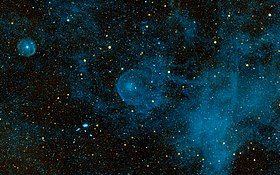IRC+10216
| Observation data Epoch J2000 Equinox J2000 |
|
|---|---|
| Constellation | Leo |
| Right ascension | 09h 47m 57.406s |
| Declination | +13° 16′ 43.56″ |
| Apparent magnitude (V) | 10.96 - 14.80 |
| Characteristics | |
| Spectral type | C9,5e |
| Apparent magnitude (R) | 10.96 |
| Apparent magnitude (J) | 7.34 |
| Apparent magnitude (H) | 4.04 |
| Apparent magnitude (K) | 1.19 |
| Variable type | Mira |
| Astrometry | |
| Proper motion (μ) |
RA: 35 ± 1 mas/yr Dec.: 12 ± 1 mas/yr |
| Parallax (π) | 10.56 ± 2.02mas |
| Distance | approx. 310 ly (approx. 90 pc) |
| Details | |
| Mass | 0.7 - 0.9 M☉ |
| Radius | 700 - 826 R☉ |
| Luminosity | 6,250 - 15,800 L☉ |
| Temperature | 1,915 - 2,105 K |
| Other designations | |
| Database references | |
| SIMBAD | data |
IRC +10216 or CW Leonis is a well-studied carbon star that is embedded in a thick dust envelope. It was first discovered in 1969 by a group of astronomers led by Eric Becklin, based upon infrared observations made with the 62 inches (1.6 m) Caltech Infrared Telescope at Mount Wilson Observatory. Its energy is emitted mostly at infrared wavelengths. At a wavelength of 5 μm, it was found to have the highest flux of any object outside the Solar System.
CW Leonis is believed to be in a late stage of its life, blowing off its own sooty atmosphere to form a white dwarf in a distant future. Based upon isotope ratios of magnesium, the initial mass of this star has been constrained to lie between 3–5 solar masses. The mass of the star's core, and the final mass of the star once it becomes a white dwarf, is about 0.7–0.9 solar masses. Its bolometric luminosity varies over the course of a 649-day pulsation cycle, ranging from a minimum of about 6,250 times the Sun's luminosity up to a peak of around 15,800 times. The overall output of the star is best represented by a luminosity of 11,300 L☉.
The carbon-rich gaseous envelope surrounding this star is at least 69,000 years old and the star is losing about (1–4) × 10−5 solar masses per year. The extended envelope contains at least 1.4 solar masses of material. Speckle observations from 1999 show a complex structure to this dust envelope, including partial arcs and unfinished shells. This clumpiness may be caused by a magnetic cycle in the star that is comparable to the solar cycle in the Sun and results in periodic increases in mass loss.
...
Wikipedia

